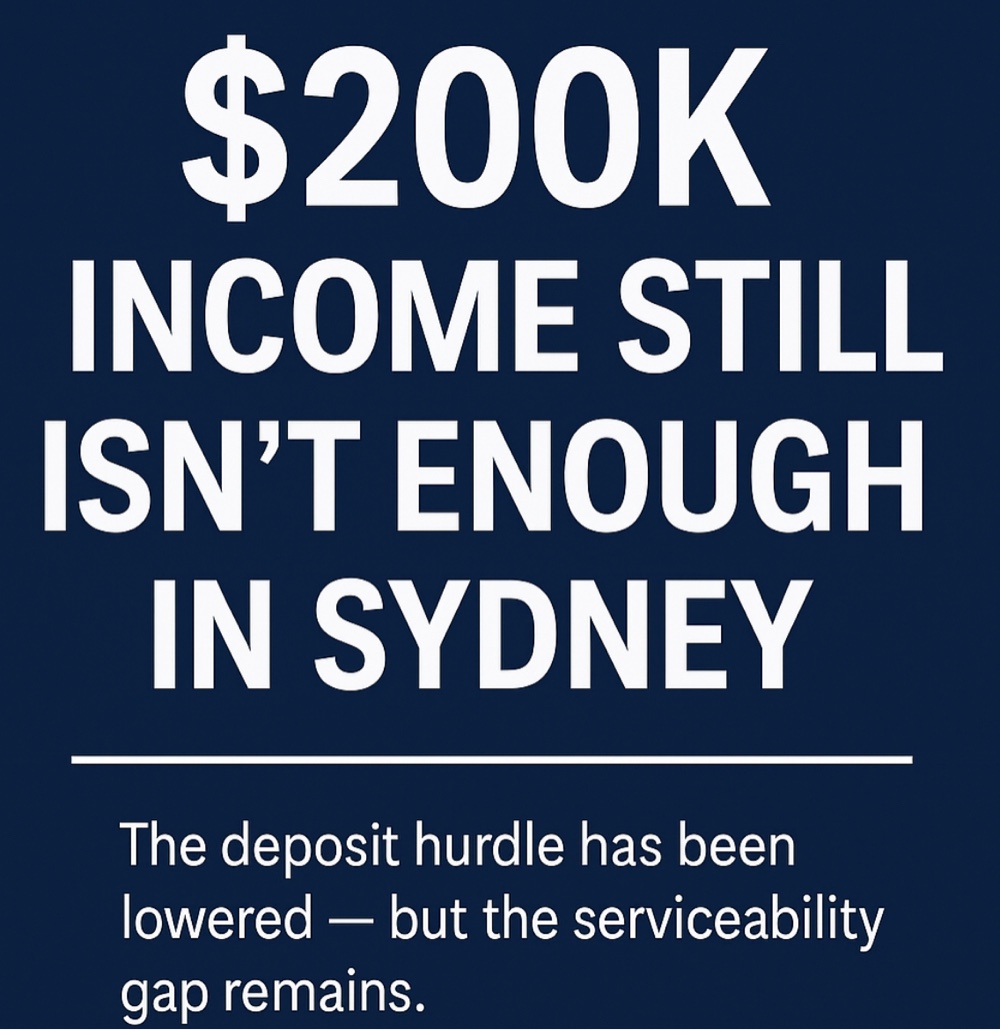
The Federal Government’s Home Guarantee Scheme has been welcomed by many first-home buyers. By lowering the deposit hurdle from 20% to just 5%, it promises to cut the savings timeline by up to seven years.
But while the deposit gap has been narrowed, a far bigger problem remains: the income-serviceability gap. Put simply, Australians can now save a deposit sooner — but they can’t borrow enough to buy at the government’s price caps.
Understanding the 5% Deposit Home Guarantee
Under the scheme, eligible first-home buyers can purchase properties at capped prices with just a 5% deposit:
- Sydney: $1.5 million cap → 5% deposit = $75,000 → loan required = $1.425m
- Melbourne: $950,000 cap → 5% deposit = $47,500 → loan required = $902,500
- Brisbane: $1 million cap → 5% deposit = $50,000 → loan required = $950,000
These numbers look attractive at first glance. However, banks assess borrowing power with a serviceability buffer (typically 3% above the loan rate, as required by APRA). That’s where the gap appears.
Borrowing Power vs Loan Needed
Here’s how borrowing capacity stacks up at different household incomes, using standard assumptions (30% of disposable income available, 30-year loan, 6.25% rate + buffer):
|
Household Income
|
3% Buffer (9.25%)
|
2% Buffer (8.25%)
|
1% Buffer (7.25%)
|
0% Buffer (6.25%)
|
|
$130k
|
~$376k
|
~$412k
|
~$453k
|
~$502k
|
|
$160k
|
~$463k
|
~$508k
|
~$559k
|
~$619k
|
|
$200k
|
~$579k
|
~$635k
|
~$699k
|
~$774k
|
|
$240k
|
~$695k
|
~$762k
|
~$839k
|
~$928k
|
Now compare these figures to the actual loans required:
- Sydney: $1.425m
- Melbourne: $902.5k
- Brisbane: $950k
Even households earning $240,000 a year fall hundreds of thousands short of what’s needed to buy under the scheme.
The Real Issue: The Serviceability “Mind Gap”
This is the hidden challenge in Australia’s housing affordability crisis:
- Buyers can now save the deposit faster, thanks to the Home Guarantee Scheme.
- But they cannot service the loan, as banks require incomes 2–4× higher than the median.
Without intervention, many households will save a deposit, only to be told by lenders that they don’t qualify for the mortgage.
Solutions: Shared Equity Schemes and Investor Partnerships
To bridge this affordability shortfall, Australia can draw lessons from NSW shared equity schemes and international housing programs.
1. Shared Equity Model
Government or private investors take a 20–30% equity stake in the property.
- Buyers borrow less, aligning repayments with their income.
- Partners share in future property growth.
2. Income-Linked Housing Support
Support scales with household income:
- Higher earners may need just 10–15% equity help.
- Lower-income households may need 25–30%.
3. Investor-Backed Bridge Funding
Private capital pools co-invest with home buyers.
- Buyers reduce their initial debt burden.
- Investors gain exposure to residential property growth.
- Exit options: buyer equity buy-back or shared sale proceeds.
Why Shared Equity is the Missing Piece
The deposit gap has been addressed. The income-serviceability gap has not. Shared equity and investor-backed solutions:
- Make home ownership accessible sooner.
- Spread housing risk between buyers, government, and investors.
- Reduce financial exclusion for middle-income households.
- Provide investors with stable, long-term exposure to the property market.
Final Word
Australia’s housing affordability debate must shift from deposit assistance to serviceability solutions.
If governments, lenders, and investors work together to create scalable shared equity partnerships, the dream of home ownership becomes achievable again — not just for high earners, but for everyday Australians.
